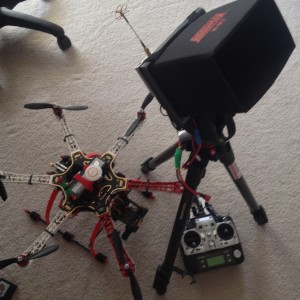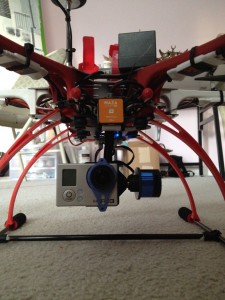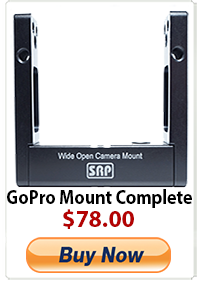The new age of aerial photography and FPV
One of the hottest things outside of the Freefly MoVi at NAB this year was from a competing multi-rotor company DJI. No it was not a camera stabilizer (although they do make them), but rather their new quad-copter the DJI Phantom. You have all probably seen or know someone who has one as they have blown up in the entry level aerial market. Beyond that the hobby seemed to explode with the release of the Phantom and this was not even much of a topic last year in our business outside of niche experts and specialists. The Phantom looks like a toy but it is in fact an excellent starter to professional GoPro camera ship. A great part of its appeal is its ability to leverage DJI’s Naza technology which for all intensive purposes provides a stable easy to fly aerial platform that does not require a lot of skill to fly. It features a 6 degrees of freedom IMU sensor built into the hardware which communicates shifts in yaw, pitch, roll, acceleration, etc to the quad copters brain telling it to counter those abrupt movements, in-tern providing stabilized flight. They system also features a fail safe in place so that if you break its 2.4Ghz radio contact the Phantom will rise up into the sky come to your launch position and land within a few feet of you (not guaranteed without the GPS upgrade option). Right outside of the box the Phantom for most of us would not cut it for any real quality GoPro work (sounds funny reading that) but with a few modifications and upgrades it can become a very serious tool or at least a gateway to bigger and better copters.
The DJI is a great entry solution that sells for $699. You are going to add probably another $600-1200 in parts, upgrades, etc to sustain it as a hobby or basic aerial platform. Do not think $699 is all you need to get into this. Here are some things you may need or want to get started:
There are several two axis gimbal options for the GoPro that pair well with the Phantom. The first of course is DJI’s own Zenmuse for GoPro Hero 3 which provides rock solid lock on horizon (or any angle you adjust to) without any sacrifices. Vibration, wind, etc are gone as is a good amount of jello that those two things introduce to the GoPro when shooting several hundred feet in the air. Another good gimbal option is the Tarot GoPro gimbal. This is the one I use as it was a fraction of the price and works just as good if not better. You will have to do a few modifications to make this work but nothing more than a few minutes of your time to achieve. Both offer pitch control as long as you have enough channels and a control on your transmitter. There are hundreds of other gimbal options as well that you can pair up with a AlexMos, EvvGc, or Martinez brushless gimbal controller board or of course you can go the servo gimbal route (again if you have the channels available and a way to control pitch)
A great option for the DJI Phantom is going with a better brain. The Naza-M v2 or Wookong auto pilot system expands on what your quadcopter can do in regards to stability and control. The DJI Wookong will allow you to program in waypoints so that you can fly from one GPS co-ordinate to another. Both offer GPS which offers better control for fail safe and coordinates for telemetry downlink. This will give you more data to improve your flying skills as well if you leverage it. If you start to get serious you will want to look into a video downlink with on screen display input so that you can fly via first person view (FPV). Flying this way is more like a video game and for most offers a much better level of flying control. This is a serious consideration for most as once your quad/hexa/octo copter is out of view there is no real way to see where it is heading which can lead to a lost investment. You cannot always bank on failsafe to recover your out of range copter so FPV can ideally be a back up for recovery if you fly out of your field of vision. For FPV you are going to need a video downlink system. Ideally you want a 2.4Ghz or 5.8Ghz transmitter and receiver with a range of at least 1km. You are looking at a 600 – 2000 transmitter with decent antennas. Test this system out before you fly so you know what channels work at the distance you need. Would suck to have video in the air and to loose it out of your field of view and end up flying blind. You will also need a bright outdoors monitor (these are all SD) and a hoodman to block glare and sun. No point in having a first person view if the sun is blocking out the image. You will need a battery to power the monitor and the receiver as well. On the copter side you will want to have some regulated 12v power for the transmitter. Some ferrite cores will reduce and interference you might get from the rest of the copter components which can cause lines in your video link. On top of this you can add an on screen display (OSD) to overlay flight data like horizon, distance, height, voltage, etc. Its always good to know if that battery is about to die so you can be proactive and fly back in advance of a potential crash.
The Phantom has a few upgrade kits to make things easier for you. One of the easiest and most recommended is the prop guard upgrade. This is great if you plan on flying indoors for example or next to buildings. The stock DJI props are very fragile and have even been known to crack in high wind flying which will cause a crash. Look at getting some carbon fiber or carbon nylon mix props. I advise against using larger props as you will burn out your stock motors and will get some erratic flying action especially in higher winds.
Want to go bigger? I use a DJI F450 quad-copter or F550 Hexa-copter which has more lift, a bigger footprint (which could be a bad thing) and more space to cram in electronics. These are sold as kits, as almost ready to fly and as ready to fly. If you have some basics in RC and electronics I would go with a basic kit (F550) which consists of 6x ESC’s, 6x motors, 6x 8″ props, 6x 10″ props, the body, arms, and power lead. You will need some solder, battery, charger, RC transmitter, RC receiver (get more than 4 channels, ideally 7 or 8), and a flight controller. For flight controllers there are several options. The first is to stick with DJI. The Naza, Naza-M v2 and Wookong are the lower to higher end controllers. These tell the motors what the receiver, GPS, power, etc commands and it in exchange determines orientation, compensations, etc to the motors. There are other third parties as well like APM, Multi Wii, Zero UAV, Arduflyer Rabbit etc. Most of these are open source and personally unless you are someone competent in Arduino programing can be a problem and unpredictable. Some of them have a gui of their own but to each his own. I personally like the DJI software as its straight forward, easy to use and now is available on iphone if you have the BTU Bluetooth module option ($50 for Naza-M v2)
If you are an expert then you do not need to read any of this. If you are looking to start big and go pro take a look at the DJI 800 or the Freefly Cinema Cinestar 8 (my dream copter). These beasts can hold a Red Epic with ease and have significant lifting power and maneuverability. When you get into this range you are looking at a serious investment and pretty much all of these are custom setup’s in regards to down link, radios, gimbal control, etc. Look at spending $7k-20K on a setup like this, not to mention the extra parts, etc you will want to have on hand. Maybe even a second one for when…..not if it crashes. I think big or small we have had at least one. When I was flying my Trex 700 helicopter I knew one day I would either never see it again or it would suffer a catastrophic crash. It crashed hard. I sold my backup and stayed away from the hobby for years. Enter the popularity of quad, hexa and quad copters. They have rejuvenated my interest and with the amazing quality of the GoPro Hero 3 Black when in 2.7K shooting in protune the doors have opened again. I am also noticing a lot of wedding shooters, sports shooters etc now getting into FPV and greatly increasing the production value by offering aerial flyovers, etc. There is nothing like a shot that starts at the ground and goes 400′ into the air or a fly around of your lead actor, etc. You can offer some epic shots that you could never have offered in the past without spending thousands of dollars to hire a specialized team. However there are guidelines and restrictions to flying that most may not know about and the law varies from state to state. Legally you can get into some big trouble if you are shooting commercially without a permit and proper clearance, etc from the FAA. You also have to remember peoples sensitivities about privacy etc are also at an all time high and your Phantom can be viewed as a drone by the guy who does not want his backyard to be filmed. Wherever you fly make sure you know your surroundings as well. Flying around people or in crowds is not a good idea. Leave that to the pros. You can seriously hurt someone even with a Phantom. You can do some serious property damage and get yourself into all kinds of legal issues if you do not plan ahead of time. Keep the communication open if you plan on flying in your neighborhood. Talk to your neighbors before you fly over their pool were someone might be sunbathing nude. Most people will be intrigued with your copter but some might think you are spying on them so do yourself a favor and get a vibe of what is and is not cool before you launch.
Last comment is that you will crash. You should have extra propellers, extra arms, ESC’s, motors, batteries, etc. Do not get into this if you can barely pay for it to have the basics. You will be disappointed if you hit a tree or it decides to take off because someones 2.4Ghz baby monitor has a stronger signal on a close channel. Do not bank on failsafe saving your investment / toy from being lost over the treeline. Be smart and fly safe.
Michael N Sutton
Twitter: @MNS1974
you can find me at Rule Boston Camera












